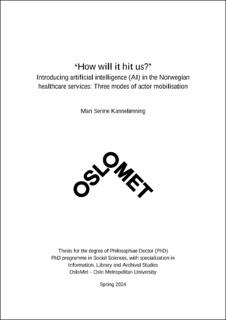‘How will it hit us?’ Introducing artificial intelligence (AI) in the Norwegian healthcare services: Three modes of actor mobilisation
Doctoral thesis
Published version
Permanent lenke
https://hdl.handle.net/11250/3112563Utgivelsesdato
2023Metadata
Vis full innførselSamlinger
Sammendrag
This thesis explores the introduction of artificial intelligence (AI) in the Norwegian healthcare services. It does so by focusing on the role of expectations and technological promises related to a future with AI in healthcare and how such visions are collectively pursued in the present. AI is widely expected to play an essential role in providing financially viable public healthcare services in the future. The expectations typically include promises of technologies that can automate repetitive tasks and support healthcare professionals in making decisions, thereby improving their work efficiency and enhancing treatment quality and patient safety. However, the current state of the introduction of AI in healthcare services worldwide is characterised by a so-called AI chasm between the expectations and the promise of AI technologies and their actual deployment in real-world clinical settings. To navigate this complex landscape, governments, health authorities, AI environments and other stakeholders perceive the need for a collective effort among those with relevant knowledge and expertise. This thesis uses the AI chasm as an entry point to explore three Norwegian initiatives that mobilise heterogeneous sets of actors in attempts to enable AI in the Norwegian public healthcare services: a national inquiry process led by the Norwegian Directorate of Health, an AI procurement process at a hospital trust and a nationwide network of professionals. These initiatives are studied through a qualitative case study approach that includes data from digital meeting observations, interviews and document analysis. Each study represents one of the three articles in this article-based thesis and explores different aspects of expectations, promises and collective work with the future of AI in healthcare as the focal point. Altogether, the case studies enabled an investigation of the overall research question of this thesis: What are the significance and implications of ‘mobilisation’ in the early phases of introducing ambiguous, complex and advanced technologies like AI in healthcare? The thesis analyses the findings from the case studies by drawing on concepts and perspectives from Science and Technology Studies (STS) dealing with innovation processes and the shaping of technological developments. With a primary focus on the aspect of actor mobilisation and Michel Callon’s (1986b) article ‘Some Elements of a Sociology of Translation: Domestication of the Scallops and the Fishermen of St Brieuc Bay’, the thesis develops a theoretical apparatus with three modes of actor mobilisation at its core: Mode 1: Steered outcome; Mode 2: Negotiated outcome; and Mode 3: Fragmented and distributed outcome. As a whole, this thesis aims to contribute to a better understanding of the role of futureoriented representations (e.g., expectations and technological promises) and the mobilisation of heterogeneous actors in the processes of introducing advanced and complex classes of technology, such as AI, into society.
Denne avhandlingen tar for seg innføringen av Kunstig Intelligens (KI) i den norske helsetjenesten ved å studere ulike aktørers forventninger og løfter om fremtiden med KI i helsetjenesten, og hvordan man kollektivt jobber mot disse fremtidsvisjonene i nåtid. Verden over er det bred enighet om at KI vil spille en viktig rolle for å opprettholde økonomisk bærekraftige helsetjenester i fremtiden. Det forventes for eksempel at KIteknologier skal kunne automatisere repetitive oppgaver, støtte helsepersonell i beslutningsprosesser, forbedre arbeidseffektivitet og øke behandlingskvalitet og pasientsikkerhet. Pågående arbeid for å introdusere KI i helsetjenesten er imidlertid preget av en såkalt «KI-kløft» [AI chasm] mellom forventningene og løftene om KI-teknologier og deres faktiske implementering i virkelige kliniske praksiser. Både regjeringer, helsemyndigheter, KI-miljøer og andre interessenter mener at en felles innsats fra aktører med ulik kunnskap og ekspertise er nødvendig for å kunne navigere i dette komplekse landskapet. Avhandlingen bruker KI-kløften som inngang til å utforske tre norske initiativer som i sine forsøk på å innføre KI i norsk helsetjeneste har mobilisert heterogene aktørgrupper: en nasjonal utredningsprosess ledet av Helsedirektoratet, en KI-anskaffelsesprosess ved et større helseforetak og et landsdekkende nettverk av fagpersoner. Disse initiativene studeres gjennom en kvalitativ casestudie-tilnærming, og studien inkluderer data fra digitale møteobservasjoner, intervjuer og dokumentanalyse. Avhandlingens tre artikler tar for seg hver sin case, og utforsker ulike aspekter ved forventninger, løfter og kollektivt arbeid som har en fremtidig helsetjeneste med KI som fokusområde. Samlet utgjør disse tre studiene grunnlaget for å svare på avhandlingens overordnede forskningsspørsmål: Hva er betydningen og implikasjonene av 'mobilisering' i tidlige faser av innføringen av flertydige, komplekse og avanserte teknologier som KI i helsetjenesten? Avhandlingen analyserer funnene fra casestudiene ved å ta i bruk begreper og perspektiver fra ‘Science and Technology Studies’ (STS) som fokuserer på innovasjonsprosesser og teknologisk utvikling. Med særlig vekt på aktørmobilisering og Michel Callons artikkel: ‘Some Elements of a Sociology of Translation: Domestication of the Scallops and the Fishermen of St Brieuc Bay’ (1986b), utvikles det en teoretisk ramme som består av tre former for aktørmobilisering: ‘Modus 1: Styrt utfall’, ‘Modus 2: Forhandlet utfall’ og ‘Modus 3: Fragmentert og distribuert utfall’. Avhandlingens mål er å bidra til en økt forståelse for rollen til fremtidsrettede representasjoner (forventninger og løfter etc.) og mobiliseringen av heterogene aktører i innføringsprosesser av avanserte og komplekse teknologiklasser som KI i samfunnet.

